Gaboon Viper
- December 6, 2023
- 0 comment
The Gaboon Viper, scientifically known as Bitis gabonica, is a mesmerising and formidable snake native to the rain forests and savannas of sub-Saharan Africa. Renowned for its distinctive appearance, the Gaboon Viper is easily identified by its large, triangular head adorned with striking geometric patterns and an array of colour variations ranging from shades of brown and Gray to vibrant yellows and greens.


This snake is the largest member of the viper family, with some individuals exceeding six feet in length. Despite its size, the Gaboon Viper is remarkably well-camouflaged in its natural habitat, relying on its cryptic coloration to blend seamlessly into the leaf litter. Known for its potent venom, the Gaboon Viper possesses the longest fangs of any snake, measuring up to two inches in length.
Despite its fearsome reputation, this snake is typically docile and prefers to rely on its impressive camouflage rather than confrontations. However, when threatened, the Gaboon Viper can deliver a potent bite that injects a potent venom, making it a creature to be respected and admired from a safe distance. Conservation efforts are crucial to ensure the survival of this magnificent serpent and to promote a balanced ecosystem in its native range.
| Characteristic | Description |
|---|---|
| Scientific Name | Bitis gabonica |
| Habitat | Rainforests and savannas of sub-Saharan Africa |
| Size | Up to 6 feet in length |
| Head Shape | Large, triangular |
| Coloration | Variable shades of brown, gray, yellow, and green |
| Camouflage | Excellent, blends into leaf litter |
| Venom | Highly potent |
| Fang Length | Up to 2 inches |
| Temperament | Generally docile, but can be defensive if threatened |
| Conservation Status | Conservation efforts are crucial for survival |
| Family | Viperidae (viper family) |
Botanical Beauty of Gaboon Viper

The Gaboon Viper, scientifically known as Bitis gabonica, stands out not only for its venomous prowess but also for its captivating botanical beauty. This serpent, native to the lush landscapes of sub-Saharan Africa, boasts a large, triangular head adorned with intricate geometric patterns. Its coloration spans a spectrum from earthy browns and gray to vibrant yellows and greens, making it a visually striking and uniquely camouflaged creature in its natural habitat.
Venomous or Not Venomous?
The Gaboon Viper is renowned for its potent venom, delivered through the longest fangs of any snake, measuring up to a remarkable two inches. Despite this, its temperament is generally docile, and it prefers relying on its exceptional camouflage rather than engaging in confrontations. Exploring the delicate balance between its venomous capabilities and its non-aggressive demeanor provides a nuanced understanding of this intriguing species.

Ecological Importance
Within its ecosystem, the Gaboon Viper plays a crucial role. As an apex predator, it helps regulate the population of various prey species, contributing to the overall balance of the ecosystem. Understanding the ecological importance of the Gaboon Viper sheds light on the intricate web of relationships that sustains the biodiversity of its habitat.
Habitat and Behavior
Adapting to the rain forests and savannas of sub-Saharan Africa, the Gaboon Viper showcases fascinating behavior and survival strategies. Its preference for leaf litter as a means of camouflage and its strategic choice of habitats provide insights into its evolutionary adaptations. Exploring the interplay between its behavior and chosen environment deepens our appreciation for its resilience and survival instincts.
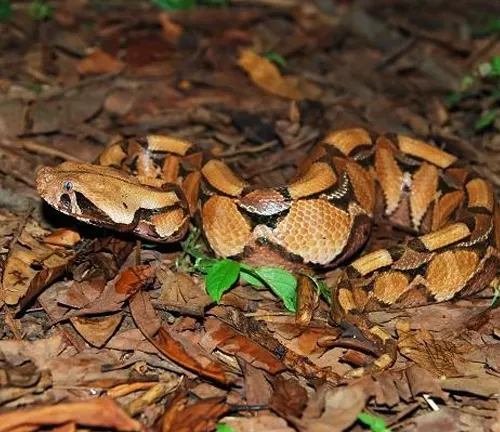
Art And Culture
Beyond the realms of biology, the Gaboon Viper has made its mark in art and culture. Its captivating appearance and potent symbolism have inspired indigenous art forms and narratives. Delving into the cultural significance of the Gaboon Viper unveils a rich tapestry of human-animal relationships, where respect and fear often intertwine.
Survival
Survival in the wild is a constant challenge, and the Gaboon Viper has evolved remarkable strategies for this purpose. From its cryptic coloration to its calculated movements, understanding the intricacies of its survival mechanisms provides a glimpse into the resilience of this species in the face of various environmental pressures.
Conservation
Conservation efforts are paramount to ensure the Gaboon Viper’s continued existence. As human activities impact its natural habitat, understanding the threats it faces and implementing measures for conservation become imperative. Examining ongoing initiatives and advocating for the preservation of its ecosystem are essential for securing the future of this remarkable snake.
Common Food
The Gaboon Viper’s diet is diverse and includes small mammals, birds, and amphibians. Exploring its common food sources sheds light on its role in regulating prey populations and maintaining the ecological balance within its habitat. Understanding its dietary preferences provides a holistic view of its ecological niche.
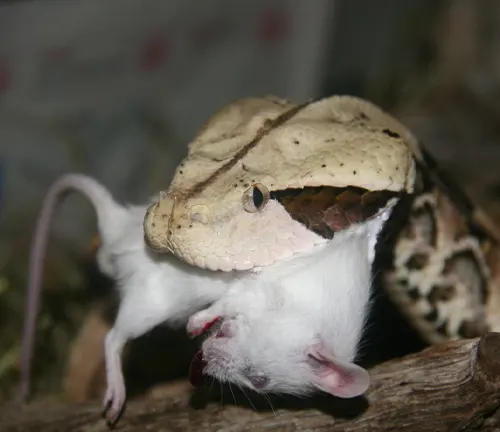
Benefits
Despite its venomous nature, the Gaboon Viper offers benefits to its ecosystem and potentially to humans. Research into the components of its venom could yield insights for medical applications, showcasing the potential positive contributions of this enigmatic species beyond its fearsome reputation. Understanding the benefits it brings to both its habitat and potentially to medical science broadens our perspective on its significance in the natural world.
Different Species
Bitis gabonica gabonica
This is the nominate subspecies, found in the rain forests and savannas of West and Central Africa. It is known for its large size, distinctive markings, and vibrant coloration.
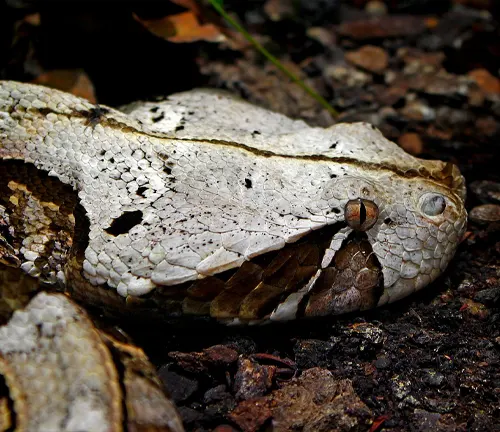
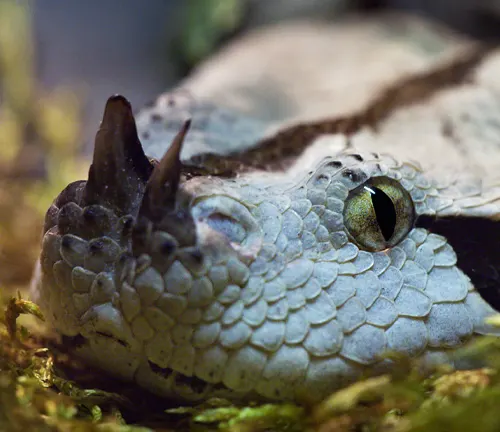
Bitis gabonica rhinoceros
This subspecies is found in East Africa, particularly in Kenya and Tanzania. It is often characterised by a more muted colour palette and has been observed to have a horn-like scale on the tip of its snout.
Frequently Asked Questions (FAQs)
1. What is a Gaboon Viper?
The Gaboon Viper (Bitis gabonica) is a venomous snake native to sub-Saharan Africa, known for its striking appearance and potent venom.
2. What does the Gaboon Viper look like?
The Gaboon Viper has a large, triangular head with geometric patterns. It varies in color, ranging from browns and grays to vibrant yellows and greens, providing excellent camouflage in its natural habitat.
3. Is the Gaboon Viper venomous?
Yes, the Gaboon Viper is highly venomous. It possesses the longest fangs of any snake, measuring up to two inches.
4. What is the habitat of the Gaboon Viper?
Gaboon Vipers are found in the rainforests and savannas of sub-Saharan Africa, where they thrive in environments with ample leaf litter for camouflage.
5. How big do Gaboon Vipers get?
Gaboon Vipers are the largest members of the viper family, with some individuals exceeding six feet in length.
6. Are Gaboon Vipers aggressive?
Gaboon Vipers are generally docile and prefer to rely on their camouflage rather than confrontations. However, they can be defensive when threatened.
7. What is the ecological importance of Gaboon Vipers?
As apex predators, Gaboon Vipers play a crucial role in regulating prey populations, contributing to the overall balance of their ecosystems.
8. How does the Gaboon Viper hunt?
Gaboon Vipers are ambush predators, relying on their excellent camouflage to remain hidden until prey comes within striking distance. They then deliver a quick and accurate bite.
9. Are there different species of Gaboon Vipers?
The Gaboon Viper (Bitis gabonica) has recognised subspecies, such as Bitis gabonica gabonica and Bitis gabonica rhinoceros, each with distinct characteristics.
10. Is the Gaboon Viper endangered?
The conservation status of the Gaboon Viper varies, and conservation efforts are important to ensure its survival, especially as its habitat faces threats from human activities.
11. What do Gaboon Vipers eat?
Gaboon Vipers feed on a varied diet that includes small mammals, birds, and amphibians. Their feeding habits contribute to the regulation of prey populations in their ecosystem.
12. Can Gaboon Viper venom be used for medical purposes?
Research into the components of Gaboon Viper venom has potential applications in medicine, and scientists are exploring its properties for various therapeutic purposes.





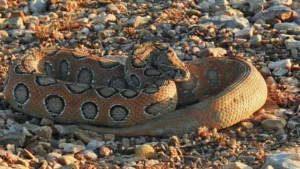


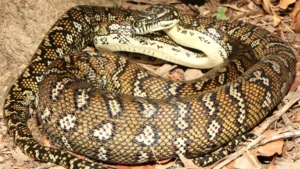
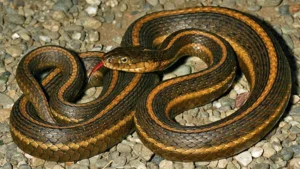


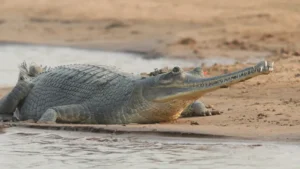
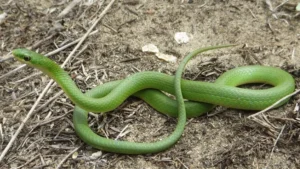
Leave your comment